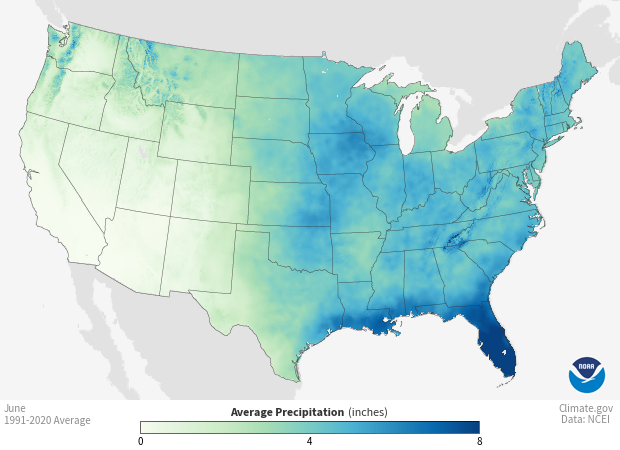Data Snapshots Image Gallery
Precipitation - 1991-2020 Monthly Average
- Dataset Details
- Twelve monthly images for 1991-2020
- Download Directories
- Click on any of the links below to view a directory listing of images and assets related to this dataset.
Based on daily observations from 1991-2020, colors on the map show long-term average precipitation totals in 5x5 km grid cells for the month displayed. The darker the color, the higher the total precipitation.
Daily totals of rain and snow come from weather stations in the Global Historical Climatology Network (GHCN-D). Volunteer observers or automated instruments gathered the data from 1991 to 2020 and submitted them to the National Centers for Environmental Information (NCEI). After scientists checked the quality of the data to omit any systematic errors, they calculated each station’s monthly total and plotted it on a 5x5 km gridded map. To fill in the grid at locations without stations, a computer program interpolates (or estimates) values, accounting for the distribution of stations and various physical relationships, such as the way temperature changes with elevation. The resulting product is the NOAA Monthly U.S. Climate Gridded Dataset (NClimGrid).
White areas on the map received an average of zero measurable precipitation during the month from 1991-2020. Areas shown in the lightest green received a monthly average of less than one inch of water from rain or snow over the 30-year period. The darker the color on the map, the higher the average precipitation total for the month. Areas shown in dark blue received an average of eight or more inches of water that fell as either rain or snow. Note that snowfall totals are reported as the amount of liquid water they produce upon melting. Thus, a 10-inch snowfall that melts to produce one inch of liquid water would be counted as one inch of precipitation.
Understanding these values provides insight into the “normal” conditions for a month. This type of information is widely used across an array of planning activities, from designing energy distribution networks, to the timing of crop and plant emergence, to choosing the right place and time for recreational activities.
Data Snapshots are derivatives of existing data products: to meet the needs of a broad audience, we present the source data in a simplified visual style. This set of snapshots is based on climate data (NClimGrid) produced by and available from the National Centers for Environmental Information (NCEI). To produce our images, we invoke a set of scripts that access the source data and represent them according to our selected color ramps on our base maps.
The data used in these snapshots can be downloaded from different places and in different formats. We used these specific data sources:
NClimGrid Precipitation Normals
References
NOAA Monthly U.S. Climate Gridded Dataset (NClimGrid)
NOAA Monthly U.S. Climate Divisional Database (NClimDiv)
Improved Historical Temperature and Precipitation Time Series for U.S. Climate Divisions)
NCEI Monthly National Analysis)
Climate at a Glance - Data Information)
NCEI Climate Monitoring - All Products
- Data Provider
- National Centers for Environmental Information (NCEI)
- Source Data Product
- NOAA Monthly U.S. Climate Gridded Dataset (NClimGrid)
- Access to Source Data
- NCEI direct HTTPS download
- Reviewer
- Chris Fenimore, National Centers for Environmental Information
